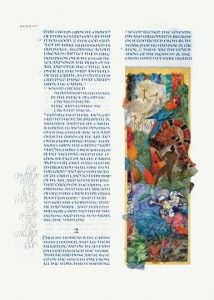In these images, how many elements from the creation story do you see? The panels and gold squares at the top of the Garden image, the gold frame of God’s creation, including the coral snake, etc. Creation is abundant and fertile; it escapes the image’s boundaries. The predatory harlequin shrimp, the coral snake, and several poisonous insects are premonitions of the Fall from innocence. 
The Adam and Eve figures, according to Susan Sink in The Art of the Saint John’s Bible (vol. 1, p. 19), are “inspired by photographs of the Karo tribe of the Omo River in southwest Ethiopia,” representing current archaeological and anthropological theories that humankind evolved from African predecessors. Man’s dominion over nature is present in both images: in the Garden’s cave drawings that depict humans’ need to tell stories; in the figures’ painted faces and the colorful cloth frame, demonstrating humanity’s “desire to rejoice in being alive.” Sink continues, “people make patterns, like the textile patterns and the curved piece of a mandala at the center left of the Garden of Eden miniature.
 The Saint John’s Bible contains many mandala (“circle”, roughly) images and through these images makes connections to many faith traditions. Hildegard von Bingen saw mandala shapes in the visions she received from God, and the mandala is found throughout Christian architecture, in decorated dome ceilings and in the rose windows of cathedrals. Donald Jackson says, “The Buddhist mandala…is about the birth of intellect.”
The Saint John’s Bible contains many mandala (“circle”, roughly) images and through these images makes connections to many faith traditions. Hildegard von Bingen saw mandala shapes in the visions she received from God, and the mandala is found throughout Christian architecture, in decorated dome ceilings and in the rose windows of cathedrals. Donald Jackson says, “The Buddhist mandala…is about the birth of intellect.”